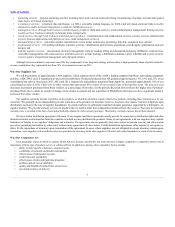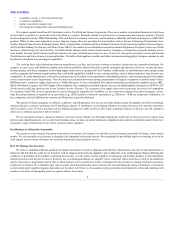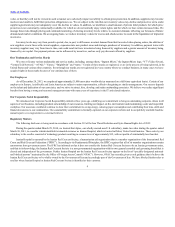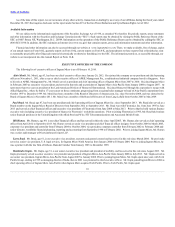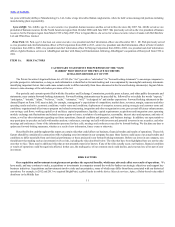Ingram Micro 2013 Annual Report Download - page 17
Download and view the complete annual report
Please find page 17 of the 2013 Ingram Micro annual report below. You can navigate through the pages in the report by either clicking on the pages listed below, or by using the keyword search tool below to find specific information within the annual report.
Table of Contents
Likewise, unanticipated changes to our transaction tax liabilities could adversely affect our future results of operations, cash flows and our competitive
position. We engage in a high volume of transactions where multiple types of consumption, commercial and service taxes are potentially applicable. An
inability to appropriately identify, charge, remit and document such taxes, along with an inconsistency in the application of these taxes by the applicable
taxing authorities, may negatively impact our gross and operating margins, financial position or cash flows.
We are subject to the continuous examination of both our income and transaction tax returns by the Internal Revenue Service and other domestic and
foreign tax authorities. While we regularly evaluate our tax contingencies and uncertain tax positions to determine the adequacy of our provision for income and
other taxes based on the technical merits and the likelihood of success resulting from tax examinations, any adverse outcome from these continuous
examinations may have an adverse effect on our operating results and financial position.
Our goodwill and identifiable intangible assets could become impaired, which could reduce the value of our assets and reduce our net income
in the year in which the write-off occurs. Goodwill represents the excess of the cost of an acquisition over the fair value of the assets acquired. We also
ascribe value to certain identifiable intangible assets, which consist primarily of customer relationships and trade names, among others, as a result of
acquisitions. We may incur impairment charges on goodwill or identifiable intangible assets if we determine that the fair values of the goodwill or identifiable
intangible assets are less than their current carrying values. We evaluate, on a regular basis, whether events or circumstances have occurred that indicate all, or
a portion, of the carrying amount of goodwill may no longer be recoverable, in which case an impairment charge to earnings would become necessary.
A decline in general economic conditions or global equity valuations could impact our judgments and assumptions about the fair value of our businesses
and we could be required to record impairment charges on our goodwill or other identifiable intangible assets in the future.
We have incurred and will incur additional depreciation and amortization expense over the useful lives of certain assets acquired in connection with
business combinations, and to the extent that the value of goodwill or intangible assets with indefinite lives acquired in connection with a business
combination and investment transaction become impaired, we may be required to incur material charges relating to the impairment of those assets. For
example, we had $527,526 of goodwill and $375,423 of identifiable net intangible assets recorded in connection with various acquisitions as of
December 28, 2013. If our future results of operations for these acquired businesses do not perform as expected or are negatively impacted by any of the risk
factors noted herein or other unforeseen events, we may have to recognize impairment charges which would adversely affect our results of operations.
Changes in our credit rating or other market factors, such as adverse capital and credit market conditions or reductions in cash flow from
operations, may affect our ability to meet liquidity needs, reduce access to capital, and/or increase our costs of borrowing. Our business requires
significant levels of capital to finance accounts receivable and product inventory that is not financed by trade creditors. This is especially true when our
business is expanding, including through acquisitions, but we still have substantial demand for capital even during periods of stagnant or declining net sales.
In order to continue operating our business, we will continue to need access to capital, including debt financing and inbound and outbound flooring and draft
discounting facilities. In addition, changes in payment terms with either suppliers or customers could increase our capital requirements. Our ability to repay
current or future indebtedness when due, or have adequate sources of liquidity to meet our business needs may be affected by changes to the cash flows of our
subsidiaries. A reduction of cash flow generated by our subsidiaries may have an adverse effect on our liquidity. Under certain circumstances, legal, tax or
contractual restrictions may limit our ability or make it more costly to redistribute cash between subsidiaries to meet our overall operational or strategic
investment needs, or for repayment of indebtedness requirements.
We believe that our existing sources of liquidity, including cash resources and cash provided by operating activities, supplemented as necessary with
funds available under our credit arrangements, will provide sufficient resources to meet our working capital and cash requirements for at least the next twelve
months. However, volatility and disruption in the capital and credit markets, including increasingly complex regulatory constraints on these markets, may
increase our costs for accessing the capital and credit markets. In addition, adverse capital and credit market conditions may also limit our ability to replace,
in a timely manner, maturing credit arrangements or our ability to access committed capacities or the capital we require may not be available on terms
acceptable to us, or at all, due to inability of our finance partners to meet their commitments to us. Furthermore, if we do not meet various covenant
requirements of our corporate finance programs, including cross-default threshold provisions, we may not be able to access the majority of our credit
programs with our finance partners. The lack of availability of such funding could harm our ability to operate or expand our business.
In addition, our cash and cash equivalents (including trade receivables collected and/or monies set aside for payment to creditors) are deposited and/or
invested with various financial institutions located in the various countries in which we operate.
17


